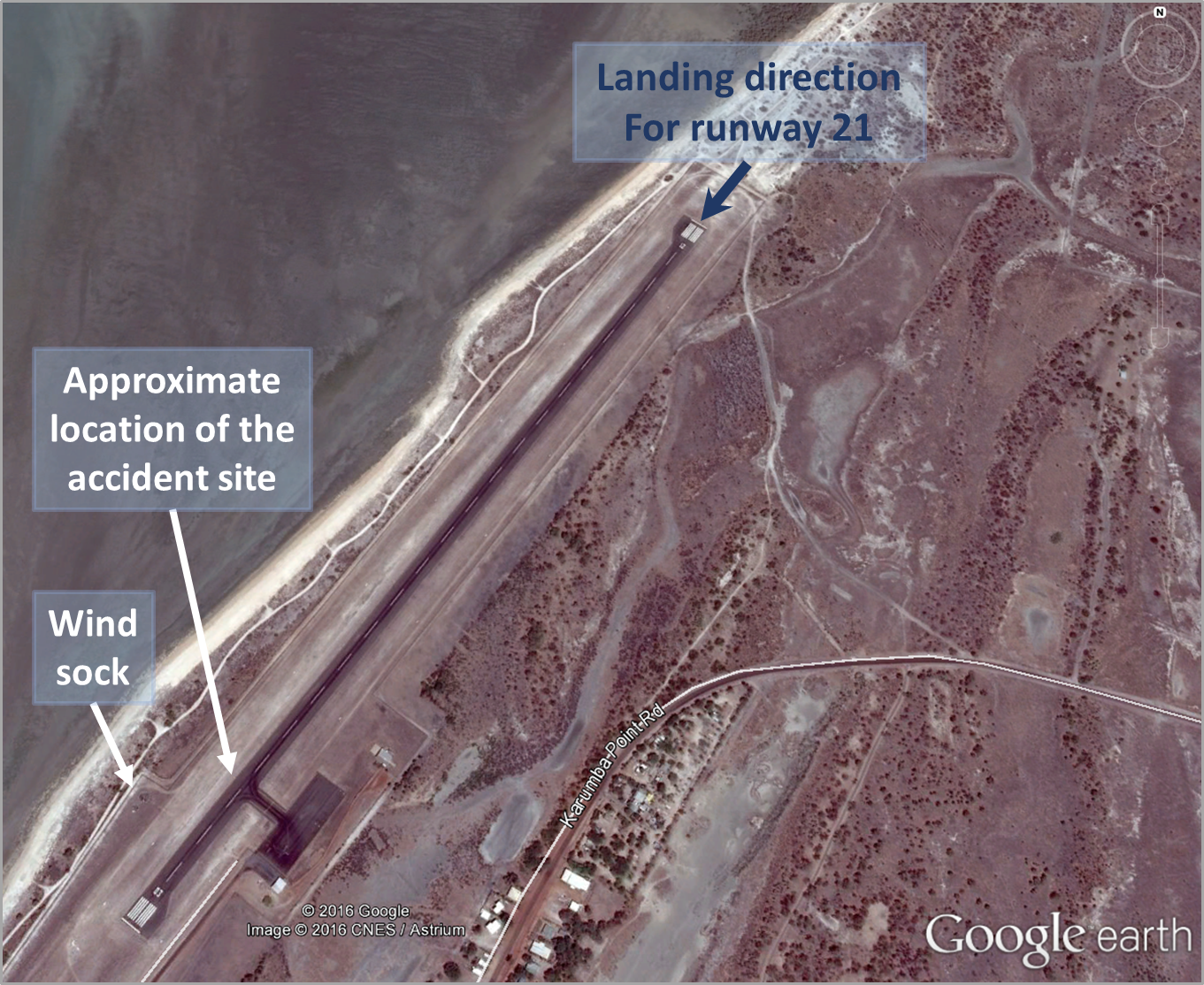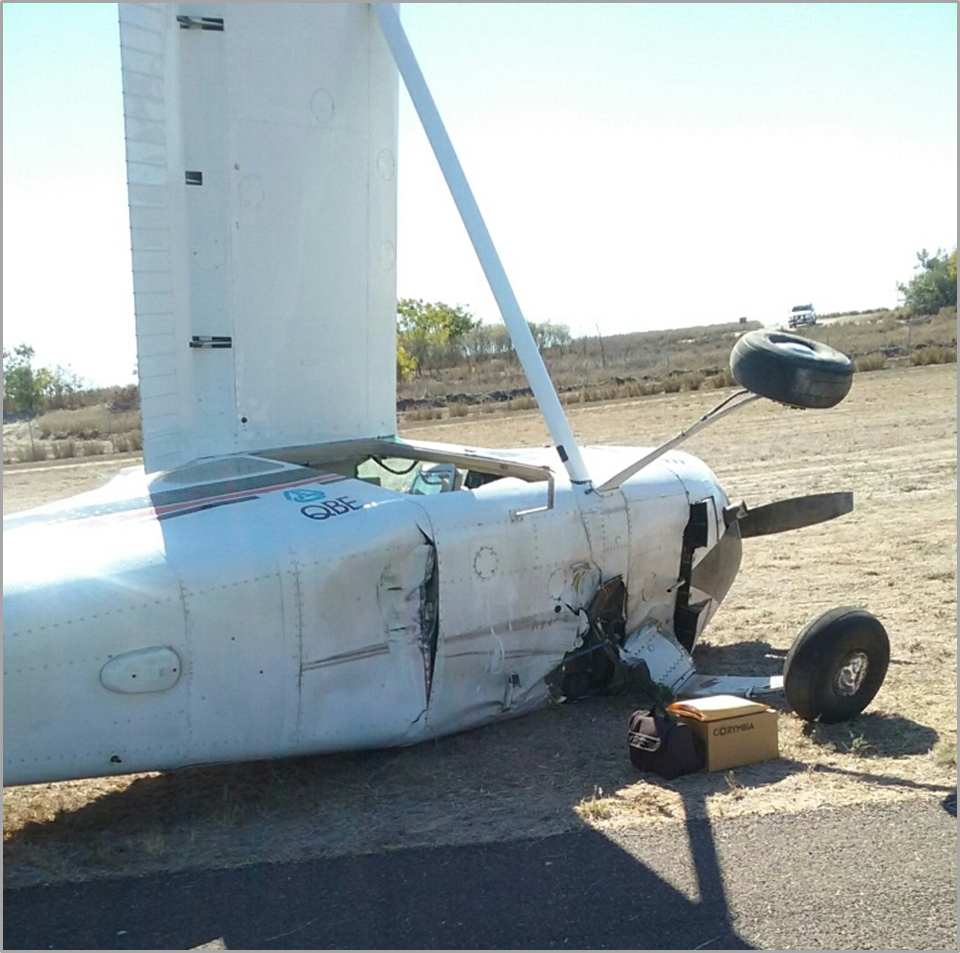What happened
On 1 September 2015, a Cessna 180C aircraft, registered VH-FDH (FDH), departed Normanton for Karumba Airport, Queensland at about 1435 Eastern Standard Time (EST). The pilot and two passengers were on board for the private flight. The aircraft had a tail wheel landing gear and the landing technique planned to be used was a wheel landing (see Landing techniques below).
At Normanton, the aircraft was refuelled and departed at almost maximum take-off weight. The aircraft climbed to about 1,000 feet for the short distance to Karumba (about 20 NM). On approaching Karumba, the pilot used the aircraft radio to contact another pilot who had just landed at Karumba to ascertain the weather conditions and to determine the most suitable runway for a landing. The pilot of the aircraft that just landed indicated to the pilot that the wind was directly across the runway from the north-west and either runway direction would be suitable for a landing. They decided to land on runway 21 (Figure 1) and joined the circuit on the downwind leg. On downwind, the windsock was observed and confirmed that the wind direction was directly across the runway from the north-west and the pilot estimated the wind speed to be about 10 knots.
Accident site of Cessna 180C, VH-FDH

Source: Carpentaria Shire Council
Figure 1: Map of Karumba Airport

Source: Google earth, modified by the ATSB
The aircraft was established in a stable final approach and the pilot determined that there was no crosswind correction required. The main wheels touched down firmly on the runway and the aircraft bounced about 3 to 4 feet. The pilot moved the control column forward slightly to stop the tail from touching the runway. The main wheels touched again at about the same time as the pilot noted that the nose started to move to the right (turning into wind). The pilot moved the aircraft controls to straighten the aircraft in line with the runway, but the aircraft did not respond to the correction. The tail continued to move quickly around (ground loop) [1] before the pilot could take any other action. The pilot was pushed up against the cockpit door. A very loud bang was heard as the left main landing gear failed, the left wing folded up and the fuselage tilted onto its side where the aircraft skidded a short distance to a stop. The aircraft stopped, almost pointing back in the opposite direction to the landing, partly on the grass beside the runway (Figure 2). The pilot turned off the engine magnetos, aircraft fuel, and electrical master switch. The two passengers exited the cockpit right door with the help of bystanders and then the pilot exited the same way. The pilot received minor injuries and the two passengers were uninjured. The aircraft was substantially damaged.
Figure 2: Cessna C180 FDH accident site

Source: Carpentaria Shire Council
Landing techniques
There are two landing techniques that can be used in tail wheel aircraft. A wheel landing is where the tail of the aircraft is held off the runway and the main wheels touch down first and then the tail wheel. The other landing technique used in a tail wheel aircraft is the three-point landing where the two main wheels and tail wheel touch the runway together.
Pilot training and tail wheel experience
The pilot had about 1,200 total flight hours with about 84 hours in tail wheel aircraft. The majority of landings in those tail wheel aircraft were three-point landings. The pilot commenced training in 2006 for a tail wheel endorsement, initially training in an Avions Mudry CAP 10, where only three-point landings were practiced. The pilot gained further training in an American Champion Super Decathlon, focussing on the wheel landing technique. During an aerobatics and formation endorsement in the Super Decathlon, the pilot revised both wheel and three-point landings. The pilot was also checked-out to fly an Aviat Aircraft Husky and a de Havilland Chipmunk, although reported only having a few hours in each. The pilot conducted a biannual flight review in March 2015 in a Cessna 172 (tricycle landing gear aircraft). The pilot had flown one other Cessna 180 and in that aircraft, had conducted three-point landings.
Of the pilots 84 hours in tail wheel aircraft, 30 were in a Cessna 180, and in the preceding 30 days, about 23 hours were in FDH.
Pilot comment
The flight was part of an air race and prior to the accident they had conducted about 20 hours of flying, departing Jandakot, and landing at Esperance, Forrest, Ayers Rock, Alice Springs, Davenport Downs, Winton, and Normanton. Of those landings, the pilot reported not being happy with any of the landings. The pilot indicated that this was the first landing in the aircraft that was conducted at almost the maximum landing weight and with a significant crosswind. All the other landings were with little to no crosswind component.
The pilot reported that the owner of FDH, who was also a pilot (medical not current), was extremely proficient at conducting wheel landings and wanted the pilot to conduct wheel landings in FDH. The pilot had conducted circuits with the owner about 2.5 weeks prior to the air race and recalled mentioning to the owner that they felt more comfortable conducting three-point landings.
The pilot reported that during the landing, they were very focused on keeping the aircraft straight with the runway and recovering from the bounce. On another landing in FDH where the aircraft had bounced about 3 to 4 feet, the pilot reported resolving the landing without going around.
Safety message
The US Federal Aviation Administration (FAA) discusses in their publication Airplane Flying Handbook Chapter 13 Transition to Tailwheel Airplanes the importance to land with the aircraft in the longitudinal axis exactly parallel to the direction the aircraft is moving along the runway. If the aircraft lands while in a crab or while drifting, it imposes severe side loads on the landing gear and imparts ground looping (swerving) tendencies. The handbook is available from the FAA website.
Aviation Short Investigations Bulletin - Issue 48
Purpose of safety investigationsThe objective of a safety investigation is to enhance transport safety. This is done through:
It is not a function of the ATSB to apportion blame or provide a means for determining liability. At the same time, an investigation report must include factual material of sufficient weight to support the analysis and findings. At all times the ATSB endeavours to balance the use of material that could imply adverse comment with the need to properly explain what happened, and why, in a fair and unbiased manner. The ATSB does not investigate for the purpose of taking administrative, regulatory or criminal action. TerminologyAn explanation of terminology used in ATSB investigation reports is available here. This includes terms such as occurrence, contributing factor, other factor that increased risk, and safety issue. Publishing informationReleased in accordance with section 25 of the Transport Safety Investigation Act 2003 Published by: Australian Transport Safety Bureau © Commonwealth of Australia 2016
Ownership of intellectual property rights in this publication Unless otherwise noted, copyright (and any other intellectual property rights, if any) in this report publication is owned by the Commonwealth of Australia. Creative Commons licence With the exception of the Coat of Arms, ATSB logo, and photos and graphics in which a third party holds copyright, this publication is licensed under a Creative Commons Attribution 3.0 Australia licence. Creative Commons Attribution 3.0 Australia Licence is a standard form licence agreement that allows you to copy, distribute, transmit and adapt this publication provided that you attribute the work. The ATSB’s preference is that you attribute this publication (and any material sourced from it) using the following wording: Source: Australian Transport Safety Bureau Copyright in material obtained from other agencies, private individuals or organisations, belongs to those agencies, individuals or organisations. Where you wish to use their material, you will need to contact them directly. |
__________


